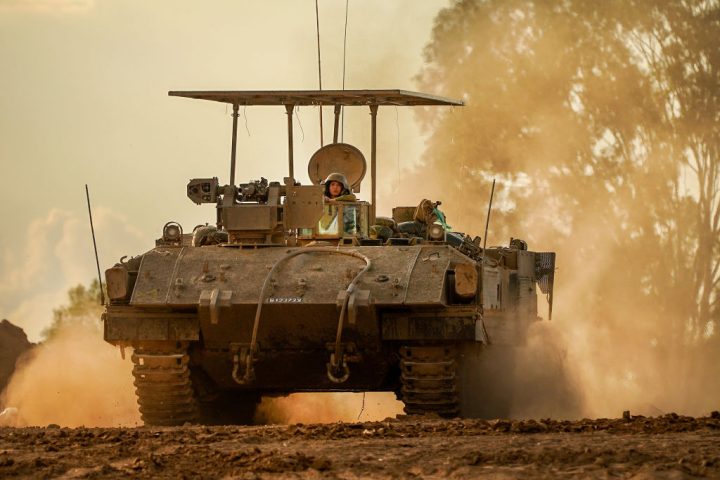For Israel, the war in Gaza is a zero sum game. Israel must win and Hamas must lose. Nothing but total victory over Hamas after the appalling terrorist attacks which left over 1,400 Israelis dead, hundreds injured and over 200 civilians taken hostage, will suffice. But how is victory going to be defined and what is Israel’s end game?
When the dust of war finally settles what does Israel want Gaza to look like? An empty, lifeless, bomb-cratered ruin or a self-governing entity, secure within its own borders and no longer a threat to Israel? Unless Israel has a clear strategic aim, its troops risk becoming trapped inside Gaza, possibly fighting a war lasting months or years end which loses all legitimacy.
In all likelihood Hamas may well have more fighters in its ranks today than it did prior to 7 October
All military operations are time dependent and any seasoned commander will always claim there is never enough of it. The war in Gaza is no different and is partly being driven by military time, which indicates how long the Israeli Defence Forces need to accomplish the mission.
But the military operation is also subject to diplomatic time, which is moving much faster, and represents the time available before Israel’s allies say the killing of civilians must stop. The human cost of the war in Gaza is difficult to verify with any accuracy. Hamas claims that around 11,000 civilians have been killed and possibly half of those could be children.
The international position of many of Israel’s allies is already hardening irrespective of whether that casualty toll is accurate. President Emmanuel Macron of France was the first to break cover when he called on Israel to stop killing women and babies.
Speaking the day after a humanitarian aid conference in Paris, the French president said the ‘clear conclusion’ of all governments and agencies present at that summit was ‘that there is no other solution than first a humanitarian pause, going to a ceasefire, which will allow [us] to protect… all civilians having nothing to do with terrorists. De facto – today, civilians are bombed – de facto. These babies, these ladies, these old people are bombed and killed. So there is no reason for that and no legitimacy. So we do urge Israel to stop.’
US Secretary of State Anthony Blinken has also waded in saying that too many Palestinians are being killed.
The international tensions surrounding the conflict were further highlighted when Israeli opposition leader Yair Lapid addressed Canada’s prime minister Justin Trudeau on social media. He said that Israel would support Trudeau’s nation if it was under attack, and Israel expects the same in return.
Trudeau had said on 14 October that the ‘killing of women, of children, of babies’ in Gaza must end.
In his message, Lapid said:
Prime minister Trudeau, Israel is defending itself in difficult conditions against a brutal terrorist organisation while trying to rescue babies, children, women and men who are being held hostage by Hamas-Isis. Responsibility for this terrible situation rests with Hamas-Isis.
Hamas launched this war, Hamas hides in civilian buildings and Hamas abuses Gazans as human shields. If Canada ever found itself under a sustained and brutal attack like the one we face now, you would find Israel by your side. We expect the same support.
Invading Gaza in the wake of the 7 October atrocities was never going to be an easy or clean operation. It was clear from the beginning of the conflict that thousands of completely innocent Palestinian civilians would be killed or wounded and lose their homes and livelihoods, given that Hamas embeds itself amongst the civilian population by placing rockets next to schools and hospitals and its headquarters in civilian neighbourhoods.
The current crisis surrounding the al-Shifa hospital in Gaza City, which has been occupied by Israeli troops in the belief that it is also home to an underground Hamas headquarters, symbolises the tragedy of the conflict. It is not a good look for Israeli Defence Forces – irrespective of whether their actions are legitimate.
The vast complex has been filled to the brim with terrified civilians seeking refuge from Israeli airstrikes. Premature babies in the hospital are at risk of dying because there is no fuel to power incubators. This is of course what Hamas wanted.
It is at this moment that Israel could change course, adopting a different military approach, without the need for a ceasefire or even so-called humanitarian pauses. They could do this simply by boxing clever and refusing to dance to Hamas’s tune.
One approach might be to refine its targeting so that air or artillery strikes are only conducted when risks to civilians are minimal. The IDF has effectively cut the Gaza strip in two and established a military base in the north from which it could presumably launch highly targeted counter insurgency operations while minimising civilians. This would show its allies that it is prepared to listen to their concerns.
The Israeli government has repeatedly stated that it wants to destroy Hamas but how is that going to be achieved? In all likelihood Hamas may well have more fighters in its ranks today than it did prior to 7 October.
Netanyahu can not possibly hope to annihilate Hamas – it’s hard to think of any counter-insurgency operation which was ever won by simply killing all of the insurgents. In the film War Machine, Brad Pitt, who plays a charismatic four star US General in command of US troops in Afghanistan, asks the question ‘If you have ten insurgents and you kill two how many do you have left? Eight, right? Wrong.’
He goes on to explain that every time you kill one insurgent, he has a brother, father, son or friend who decides they are going to join the fight. ‘In the math of counter-insurgency,’ he continues ‘Ten minus two equals 20.’






Comments